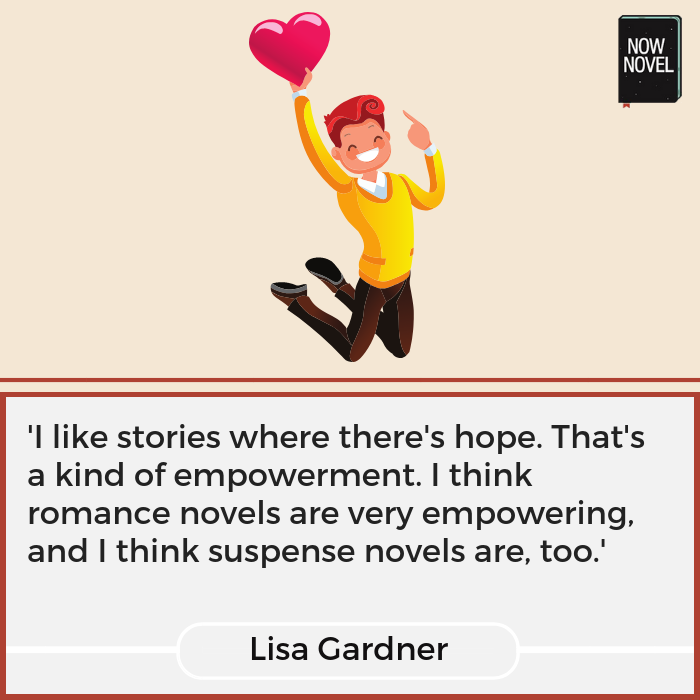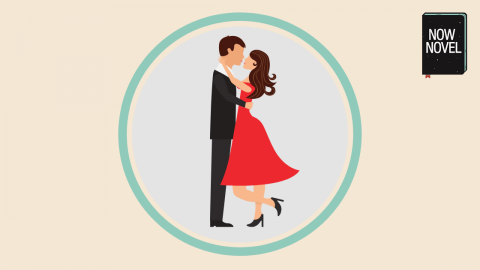In a romance novel narrative suspense and tension keep your reader turning pages. Knowing how to plot a romance novel means mastering romantic tension and several other key elements of a beautiful love story (or twisted romance). Try these 6 tips to make your romance gripping:
1. Find romance plot ideas that promise intrigue
The relationship between two characters (or more, in the case of a polyamorous story such as a love triangle) can be full of intense drama, playful banter, heartwarming intimacy and other interesting elements of human relationships.
At the same time, the best romance plot ideas bring in additional elements besides the relationship that add intrigue. Study the way blurbs for New York Times bestselling romances promise interesting story arcs:
Examples of intriguing romance plots
‘Margaret Jacobsen has a bright future ahead of her: a fiancé she adores, her dream job, and the promise of a picture-perfect life just around the corner. Then, suddenly, on what should have been one of the happiest days of her life, everything she worked for is taken away in one tumultuous moment.’
Publisher’s blurb for How to Walk Away by Katherine Center (2018)
Or this summary of Nicholas Sparks’s novel, Every Breath:
‘Hope Anderson is at a crossroads. At thirty-six, she’s been dating her boyfriend, an orthopedic surgeon, for six years. With no wedding plans in sight, and her father recently diagnosed with ALS, she decides to use a week at her family’s cottage in Sunset Beach, North Carolina, to ready the house for sale and mull over some difficult decisions about her future.
Tru Walls has never visited North Carolina but is summoned to Sunset Beach by a letter from a man claiming to be his father. A safari guide, born and raised in Zimbabwe, Tru hopes to unravel some of the mysteries surrounding his mother’s early life and recapture memories lost with her death. When the two strangers cross paths, their connection is as electric as it is unfathomable .
Publisher’s blurb for Every Breath by Nicholas Sparks (2018)
Each of these romance novel ideas contains fodder for interesting parallel plot lines. Center could explore how Margaret’s accident and rehabilitation impact her relationship. Sparks could explore how Hope’s father’s illness and Tru’s search for his own father might affect or deepen their bond.
Find a romance plot idea that includes additional parallel challenges, goals and desires for your love interests. This gives characters depth beyond just seeking a mate. Readers get multiple story arcs and unknowns to invest in, too.
2. Outline a romance where love doesn’t come easy
Sometimes love does come easy. For example, high school sweethearts stay close, marry, and live to old age.
Yet relationships that glide along effortlessly are rare. And can make boring reading. It’s the drama, the suspense and tension, that keeps us saying ‘I’m-only-going-to-read-the-next-page-before-bed’. The laughter, in the case of funny romance stories, which is it’s own kind of tension (as we wait on tenterhooks for the punchline).
The advantage of outlining your romance story and plotting key details upfront is you have an idea from the outset of possible challenges facing your lovers’ relationship.
Examples of plot points that delay romantic leads’ goals
Examples of plot points that can delay union and create romantic tension include:
- Reappearing (or even interfering) exes
- Disapproving/interfering friends or family
- Misunderstandings and negative assumptions between potential lovers
- Personal history or ‘baggage’ that potential lovers may bring to budding relationships
Many other possible obstacles can make romance plots exciting.
For example, lovers being separated by a war, like in Sébastien Japrisot’s A Very Long Engagement (1991) or Nicholas Sparks’ The Notebook (1996). Unavoidable physical distance is a useful device for keeping the question open whether or not lovers will finally be together.

3. Plot goals and complications to build narrative momentum
Lovers often have goals and complications that work against their union. In Shakespeare’s Romeo and Juliet, the doomed lovers’ feuding families are the complication standing in their way.
Goals and complications or worst case scenarios (the worst possible development that could come to pass, the fear lurking in the background) give a story narrative momentum (direction and drive towards the next plot point).
For example, in a rags to riches story where a character desires a well-off lover but is also career-driven, part of the story’s momentum may come from the juggle act of balancing romantic desires and professional ones. Maybe a character cancels a date to work late, and the love interest mistakenly reads this as disinterest.
This is an example of a plot point, a development of a situation, that plunges your reader into new uncertainties (we ask, ‘how will this misunderstanding evolve or be resolved?’)
There are two main ways to figure out the romantic goals and complications of your romance novel. One way is to outline before you begin writing and the other is to simply begin writing the first draft and see where it takes you.
To find the plot points and and character goals that shape your story, use the ‘Central Plot’ section in the Now Novel dashboard. Add ideas to your outline automatically as you go – you can always deviate from your outline as you draft. Yet a useful guide helps to prevent getting stuck.
4. Milk misunderstandings and surprises for tension
In a gripping romance story, the plot of an entire chapter could revolve around something as simple as one character’s parent coming to stay for a week unexpectedly.
A surprise scenario like this could complicate the story in many possible ways:
- A love interest who is commitment-shy might be spooked by the ‘serious’ step of meeting the lover’s parent
- The parent might disapprove of the relationship or be too controlling
- The daughter/son might be frustrated by the fact their new partner gets along with their parent better(!)
In romance stories, plot points revolve around human drama and the complex entanglements of our desires, wants, needs and fears.
Milk potential conflicts and misunderstandings to create intrigue and suspense. For example, in Jane Austen’s classic novel Pride and Prejudice, the protagonist Elizabeth Bennett misunderstands her eventual lover Mr. Darcy’s gruff manner for rudeness and disinterest at first.
This is a classic love story of two people overcoming the prejudice that results when we rely on assumptions and easy judgments.
5. Know subgenre when you create romance plots
As with other popular genres such as crime, there are many subgenres of romance. These include:

Familiarity with your sub-genre is important too. Read several books in your genre, be it historical, contemporary or paranormal romance. Take notes on when major plot points occur and what they involve. How far into the story does the first big complication or turning point occur? Try to read in other subgenres (and genres), too. It enriches your author’s palette with many colours.
6. Plot the purpose of each story section
For a by-the-book romance novel, here are the plot points a reader is going to expect in the opening:
- The characters meet
- Characters’ background goals, fears and flaws that are separate from their romance (and will impact it) need to begin to emerge
In the middle section of a good romance plot, often:
- The physical and/or emotional relationship between the characters intensifies
- Seeds of the main conflicts that keep the characters from their goals and romantic fulfillment appear
- A turning point occurs that incites greater romantic tension (the question of whether or not the lovers can find romantic fulfillment)
The final section, containing the final conflict and resolution, will occupy the final quarter of the novel:
- The climax often includes a section where everything appears hopeless and the protagonists’ future together is completely in question.
- The resolution and reward should be concise – short enough to be satisfying without being drawn out in such a way that romantic and sexual tension fizzle out.
Does the above structure sound a little too rigid?
The truth is that you should depart from it in any ways that seem logical for your own romance story. Unless you are following strict publisher-given guidelines for a category romance, find the love story you want to tell.
Join Now Novel and get peer feedback or a coach’s help turning your romance story idea into a sizzling novel.



20 replies on “How to plot a romance novel: 6 tips to sizzle”
This site has helped me to work my outline out pretty well.I will upgrade soon. to start writing it.Keep up the good work.
GREAT ARTICLE. You gave me an epiphany.
Very helpful! Thanks for this.
It’s a pleasure, Morgan! Thanks for reading.
THANK YOU for this!! I had now idea how to structure my novel but this will help 🙂
Great!
I’m getting ready to write the first of three YA romance novels in a stand alone series – this was so helpful! THANK YOU!
I don’t know how I didn’t see the comments on this article long ago. Disqus’s notification system seems a little patchy. It’s a pleasure, Caroline!
Thanx for this. Its very helpful for me.
THANK YOU!!!!!!!
It’s a pleasure! Thanks for reading.
I’m so glad I found this post because I decided to rewrite my novel into a romance. However, I am struggling with the Black moment in my story. I know my main character’s flaws, and my story has an outside antagonist, but I am stuck.
I know there needs to be a “test” of some kind that proves the character has changed, but I don’t know what to do.
Hi Marissa,
I hope you see this as quite some time has passed (I should read over older posts to catch questions such as yours). I hope you’ve overcome this hurdle! I wouldn’t say there are compulsory ingredients of a romance, like a template. But for a test, perhaps it could be a situation that brings your character’s faults to the fore? It’s difficult to advise without knowing the finer details of your plot. Good luck!
Late to the party, as usual. Romance is one of the hardest things for me to write and my first two completed MS have not a speck of romance as I feared writing it badly. This is good stuff. Thanks for sharing.
It’s a pleasure, Elias. I’d say everyone has their strong points. I’d hazard a guess from not writing them that you don’t read many romantic stories, so my suggestion would be to add a few more to your regular reading and note which romantic arcs you believe and enjoy and go from there 🙂 Personally an all time favourite for me is Love in the Time of Cholera (anything by Marquez really). That being said not every story needs romance.
Thanks for the hints. Certainly is a variety of themes but they all follow a similar pattern.
It’s a pleasure, James, thank you for reading our blog!
Thank you for this information, I have saved it for future reference as I transition from horror writing to romance — in one form or another.
Best to you in the New Year!
Hi Sue, it’s a pleasure, and best to you for your transition into writing romance and for your year ahead. It’s an interesting genre switch, good luck with it. You can find more of our articles on romance writing here.
Thank you so much for this post -it is exactly what I needed help with! I am bookmarking this blog, as I am working on my first book and I can use all the help I can get.
I’m glad to hear that, Kelly. Thanks for reading our blog and best of luck with your book.